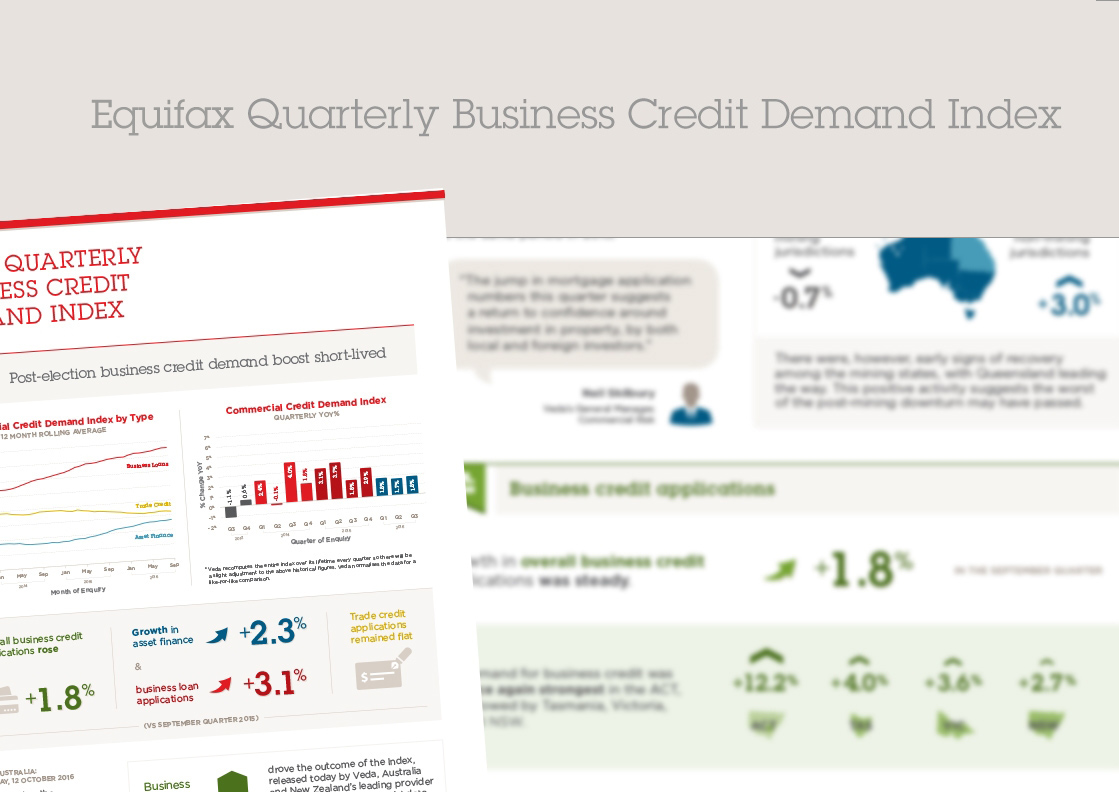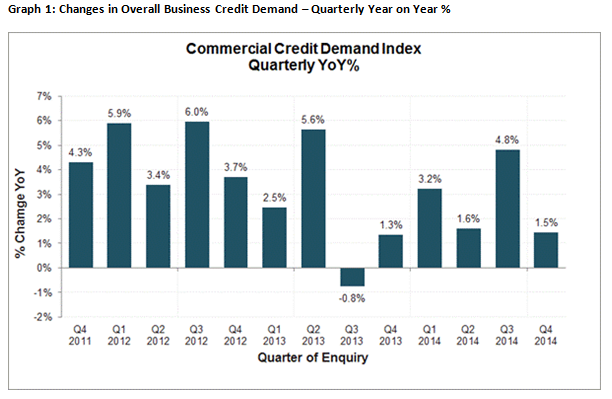Business credit demand levels out, with a modest rise in December qtr 2014

Veda Quarterly Business Credit Demand Index: December 2014
- Overall business credit applications rose 1.5% for the December quarter 2014 (vs December quarter 2013)
- Modest growth in business loans (+2.9%) and trade credit (+1.8%), although the rate of growth eased
- Asset finance declined slightly (-1.1%) (vs December quarter 2013)
Sydney, Australia: 14 January 2015 – The Veda Quarterly Business Credit Demand Index, measuring applications for business loans, trade credit and asset finance, rose at an annual rate of 1.5% in the December 2014 quarter.
The increase is reflected in modest rises in business loan applications (+2.9%) and trade credit applications (+1.8%), partially offset by a slight fall in asset finance applications (-1.1%).
The moderate increase in overall business credit applications in the December quarter shows an easing in the rate of growth from the September quarter but is in line with the 12 month trend.
Veda’s General Manager Commercial Credit, Moses Samaha, said: “During the September quarter, factors including low interest rates, the falling Australian dollar, increased marketing by major credit providers and a more settled ‘post-budget’ business outlook created a sharp upswing in business credit demand.
“By contrast, the December quarter shows a levelling out of business credit demand, and is on par with the average rate of growth over the past five quarters,” he said.
Released today, the Veda Business Credit Demand Index has historically proven to be a lead indicator of how the overall economy is performing.
The pace of growth in overall business credit applications eased in all states in the December quarter. NSW (+0.8%) and Queensland (+0.3%) saw a particularly large easing in applications growth in the December quarter, while WA (+0.3%), SA (+1.9%) and ACT (+1.9%) are also showing relatively weak growth. The strongest growth was seen in the NT (+4.2%) and in Victoria (+3.7%). Tasmania is the only state in which business credit applications are falling (-2.9%).
Business loan applications continued to grow in the December quarter (+2.9%), although the rate of growth slowed from the prior quarter. The strongest growth was seen in the ACT (+9.9%), followed by the NT (+8.5%), SA (+5.9%), and Queensland (+4.8%), while more moderate growth was seen in Victoria (+3.7%), NSW (+2.7%) and Tasmania (+1.0%). WA recorded a falling number of business loan applications (-4.7%) for the fifth consecutive quarter in December.
“The economy is continuing to adjust to the post-mining boom landscape. This is reflected in the steady upward trend in business loan applications from non-mining states, where businesses are benefiting from ongoing low interest rates,” Mr Samaha said.
Within business loans, the easing rate of applications was seen across all major account categories. Commercial mortgage applications (+2.0%) continued to ease substantially from peak growth rates of almost 40% recorded in late 2013. Applications remain solid for lending proposals (+6.6%), credit cards (+12.8%) and overdrafts (+4.2%) despite slowing in the December quarter.
Trade credit applications grew in the December quarter (+1.8%). Weak or moderate growth was seen across NSW (+0.4%), Victoria (+2.0%), Queensland (+1.4%), SA (+0.8%), and the ACT (+0.3%), while trade credit applications fell in Tasmania (-3.8%). WA (+7.1%) and the NT (+6.4%) experienced the strongest growth.
“Despite the overall slowdown in trade credit applications from the previous quarter, it is encouraging to see the transitional trend in the mining states, from a construction cycle to an operational one, continue” Mr Samaha said.
Asset finance applications softened again in the December quarter (-1.1%). Asset finance applications continued to fall in most states, with Victoria (+5.8%) the only state in which asset finance applications recorded an increase. The largest contractions appeared in the NT (-8.2%), Tasmania (-7.5%) and the ACT (-7.5%).
Within asset finance, the rate of contraction in applications for personal loans (-6.5%) and hire purchase (-1.4%) continued to ease. Positive growth in applications was seen in commercial rental (+9.7%) and leasing (+2.8%).

NOTE TO EDITORS
The Veda Quarterly Business Credit Demand Index measures the volume of credit applications that go through the Veda Commercial Bureau by credit providers such as financial institutions and major corporations in Australia. Based on this it is a good measure of intentions to acquire credit by businesses. This differs to other market measures published by the RBA/ABS, which measure new and cumulative dollar amounts that are actually approved by financial institutions.
DISCLAIMER
Purpose of Veda Indices releases: Veda Indices releases are intended as a contemporary contribution to data and commentary in relation to credit activity in the Australian economy. The information in this release does not constitute legal, accounting or other professional financial advice. The information may change and Veda does not guarantee its currency, accuracy or completeness, and you should rely on your own analysis and applications. Veda has relied on third party information in compiling the Indices and has not been able to independently verify the accuracy of that information. To the extent permitted by law, Veda specifically excludes all liability or responsibility for any loss or damage arising out of reliance on information in this release and the data in this report, including any consequential or indirect loss, loss of profit, loss of revenue or loss of business opportunity.
